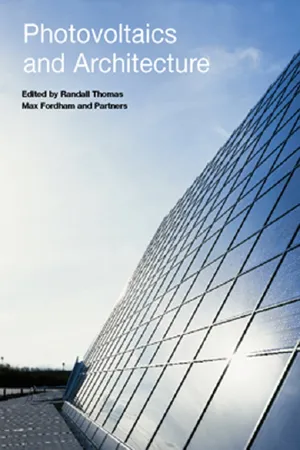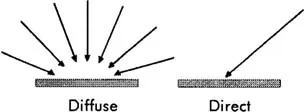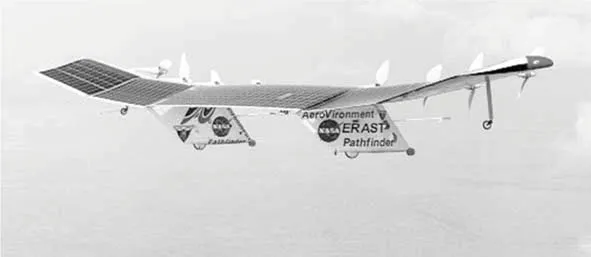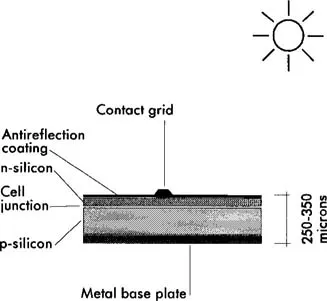
This is a test
- 168 pages
- English
- ePUB (mobile friendly)
- Available on iOS & Android
eBook - ePub
Photovoltaics and Architecture
Book details
Book preview
Table of contents
Citations
About This Book
Photovoltaic systems (PVs) produce electricity directly from solar radiation and are becoming more widespread as their advantages become apparent. This new guide provides an overview of how PVs work and how they are incorporated in the design of buildings, giving designers a good idea of the variety and flexibility of PVs and of their design and aesthetic potential. Seven contemporary case studies illustrate the use and application of photovoltaic systems.
Frequently asked questions
At the moment all of our mobile-responsive ePub books are available to download via the app. Most of our PDFs are also available to download and we're working on making the final remaining ones downloadable now. Learn more here.
Both plans give you full access to the library and all of Perlego’s features. The only differences are the price and subscription period: With the annual plan you’ll save around 30% compared to 12 months on the monthly plan.
We are an online textbook subscription service, where you can get access to an entire online library for less than the price of a single book per month. With over 1 million books across 1000+ topics, we’ve got you covered! Learn more here.
Look out for the read-aloud symbol on your next book to see if you can listen to it. The read-aloud tool reads text aloud for you, highlighting the text as it is being read. You can pause it, speed it up and slow it down. Learn more here.
Yes, you can access Photovoltaics and Architecture by Randall Thomas in PDF and/or ePUB format, as well as other popular books in Architecture & Architecture General. We have over one million books available in our catalogue for you to explore.
Information
1
Introduction
If the 19th century was the age of coal and the 20th of oil, the 21st will be the age of the sun.
Solar energy is set to play an ever-increasing role in generating the form, and affecting the appearance and construction, of buildings. The principal reason for this is that photovoltaic (PV) systems which produce electricity directly from solar radiation are becoming more widespread as their advantages become apparent and as costs fall. PVs are an advanced materials technology that will help us design buildings which are environmentally responsible, responsive and exciting. These will take a variety of forms as shown in Figures 1.1, 1.2 and 1.3. In Figure 1.1 the PVs are part of the roof structure; in the other figures they form the south-facing walls.
Figure 1.1 Model of the design for a PV canopy at the Earth Centre, Doncaster (see Chapter 11)

Figure 1.2 Solar Office, Doxford (Sunderland) (see Chapter 10)

Figure 1.3 BP Solar Showcase

This book provides an overview of how PVs work and are incorporated in the design of buildings; it gives the information that designers and, in particular, architects, need. It is for those who wish to assess the feasibility of using PVs in a specific project, for those who have already decided to use PVs and want to know how to do so and for those with the foresight to want to plan their buildings for PVs in the future. The last category has its counterpart in designers and building owners in New York who in the latter part of the 19th century built lift shafts and fitted the lifts themselves later when finances permitted. Although most applications of building-integrated PVs are not cost-effective at present, it is anticipated that they will be in the not too distant future (Chapter 4).
We have addressed new buildings especially and covered a number of building types and sectors; much of the technology could be applied as a retrofit to existing buildings. Our focus is on PV systems which are building-integrated and grid-connected. PVs are a proven, commercially-available technology. In grid-connected systems, the PVs operate in parallel with the grid, so if the PV supply is less than demand the grid supplies the balance; when there is excess energy from the PV system it can be fed back to the grid. Building-integrated, grid-connected systems have the following advantages:
• The cost of the PV wall or roof can be offset against the cost of the building element it replaces.
• Power is generated on site and replaces electricity which would otherwise be purchased at commercial rates.
• By connecting to the grid the high cost of storage associated with stand-alone systems is avoided and security of supply is ensured.
• There is no additional requirement for land.
One of our starting points is that PVs should be considered as an integral part of the overall environmental strategy of energy-efficient building design. PVs will be a key element in furthering this approach to building and will help us move towards what we call Positive Energy Architecture, ie buildings which are net energy producers over the course of a year rather than consumers.
Another starting point was planting our feet firmly in the UK – the book deals with its weather conditions. However, as can be seen from Figure 1.4, annual irradiation is similar in much of Northern Europe (sometimes referred to poetically as “the cloudy North”) and the growing PV movements in, for example, Germany and the Netherlands should encourage us.
Figure 1.4 Solar irradiation over Europe (kWh/m2/y)

The book is set out in a way that mimics the design process:
• Chapter 2 introduces some basic PV concepts.
• Chapter 3 discusses the site and building and the design options.
• Chapter 4 examines costs and sizing.
• Chapter 5 looks at the integration of PVs inside the building.
In addition we include a number of case studies, an Appendix setting out a number of technical points and a Glossary.
We have tried to set out the issues in a straightforward manner but it should be remembered that real design is always iterative, often illogical and occasionally inspired – the art is in attaining the right mixture.
We hope the book will give an idea of the variety and flexibility of PVs and of their design and aesthetic potential; if we as a design community are successful, our local and global environments will be enhanced.
2
What are photovoltaics?
2.1 Introduction
PV systems convert solar radiation into electricity. They are not to be confused with solar panels which use the sun’s energy to heat water (or air) for water and space heating. This chapter looks at PVs and examines a number of issues of interest to designers including:
• PV module size and shape.
• Colour.
• Manufacturing technology.
• Environmental issues.
• Energy production.
2.2 PVs
The most common PV devices at present are based on silicon. When the devices are exposed to the sun, direct current (DC) flows as shown in Figure 2.1 (see Appendix A for greater detail). PVs respond to both direct and diffuse radiation (Figure 2.2) and their output increases with increasing sunshine or, more technically, irradiance (Figure A.3).
Figure 2.1 Diagram of PV principle

Figure 2.2 Direct and diffuse radiation

PVs are ubiquitous. They power calculators and navigation buoys, form the wings of satellites and solar planes (Figure 2.3), and are beginning to appear on cars. As we saw in Chapter 1, a number of buildings in the UK use them, eg, the Solar Office in Doxford (Figures 1.2 and 2.4).
Figure 2.3 PV modules on a solar plane

Figure 2.4 Solar Office, Doxford

Common PVs available are monocrystalline silicon, polycrystalline silicon and thin film silicon (using amorphous silicon). A typical crystalline cell might be 100 × 100mm. Cells are combined to form modules. Table 2.1 shows typical efficiencies.
Table 2.1 PV efficiencies
| Type | Approximate cell efficiencya% | Approximate module efficiencya% |
| 1. Monocrystalline silicon | 13–17 (1) | 12–15 (2) |
| 2. Polycrystalline silicon | 12–15 (1) | 11–14 (2) |
| 3. Thin-film silicon (using amorphous silicon) | 5 (3) | 4.5–4.9 (2) |
a. Efficiencies are determined under standard test conditions (STC).
Theoretical maximum efficiencies for silicon are about 30%. Actual efficiencies are improving. In solar car races PVs with efficiencies of about 25% are being used. New materials such as copper indium diselenide (CIS) and cadmium telluride (CdTe) are being introduced. Novel approaches such as producing multijunction cells which use a wider part of the solar spectrum are another aspect of a drive to increase efficiency.
It is also useful to keep efficiencies in perspective. A tree (Figure 2.5) relies on photosynthesis, a process which has been functioning in seed plants for over 100,000,000 years and only converts 0.5–1.5% of the absorbed light into chemical energy (4).
Figure 2.5 A Cambridge tree, near an array of 17th century solar collectors (ie windows)

More recently, the national grid has proved only 25–30% efficient in providing us with electricity from fossil fuels.
Crystalline silicon cells consist of p-type and n-type silicon (Appendix A) and electrical contacts as shown schematically in Figure 2.6.
Figure 2.6 Crystalline silicon cell

The cells, which are of low voltage, are joined in series to form a module of a higher, more useful voltage. The modules (Figure 2.7) are constructe...
Table of contents
- Cover Page
- Half Title page
- Title Page
- Copyright Page
- Contents
- List of Contributors
- Foreword
- Preface
- Acknowledgements
- Part One
- Part Two
- Appendix A
- References and Bibliography
- Glossary
- Illustration Acknowledgements
- Index